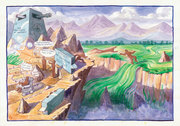I am staying at the Jagat Niwas Palace hotel on the edge of Lake Picholla, without doubt it is the most beautiful part of Udaipur. But I was so tiered after 22 hours without sleep, that after I checked in I slept for nearly 5 hours. I woke to a warm, sunny early afternoon and venturing outside my room, which opens onto a terrace, I was able to appreciate the beautiful surroundings I am in. My hotel, was originally a mansion built in the early 1600’s and its a wonderfully proportioned building formed around an open courtyard on 4 levels including a roof terrace. All the rooms open onto the courtyard and terraces and dotted around the walls are cosy nooks where you can sit and drink tea. The palace overlooks Lake Picholla around which are many other palaces, parks, hotels and other buildings. Across the lake in the distance are the hills of Rajasthan beyond which the country becomes arid and desert like. Udaipur is the historic capital of the kingdom of Mewar in the former Rajputana Agency. It was founded in 1553 by Maharana Udai Singh of the Sisodia clan of Rajput and remained as the capital city till 1818 when it became a British princely state. The city is a chaotic maze of little twisting streets full of tut-tuts, motorbikes and cars jostling with pedestrians and freely wandering cows. Down by the water’s edge people wash themselves or their clothes. This is India as I imagined it with the ancient and modern co-existing side by side. I know I’m in a place with a long history and rich cultural past and a busy present. It was frustrating not to have a guide to interpret what I was seeing: on a boat trip round the lake I could see that there were many buildings of significance but I don’t know what they were. Fortunately, I was able to use google maps to at least identify the points if interest I was looking at. As I wandered the streets I found the people to be friendly and as a foreign visitor I felt safe and welcome and I was treated with respect whenever I had a conversation. This was my introduction to the context in which my fieldwork is located.

I bought this book at the airport and thought it would be a good idea to read it as part of my prep for my visit to Swaraj. I love the core idea in the book that the world would be a better place if business that sought to make a profit, ‘give’ as well as ‘take’ from the world. I thought about my own small enterprises and viewed them from the gifting perspective. They are underpinned by the idea that we, (me and the volunteers I work with) are working on behalf of educators all over the world and the fruits of our research (our writings / magazines) are gifted to the community of interest we support through Creative Commons licences. The 1for1 model doesn’t work for us because we don’t actually sell anything, we give our own time to develop the perspectives that we then share freely. Blake’s story challenges me to ask, ‘is that enough?’. Can we go further to provide gifts for people who have far fewer educational opportunities than I have had. Perhaps my visit to Swaraj will help me explore this question.




 RSS Feed
RSS Feed